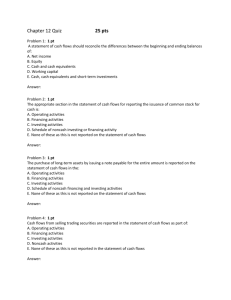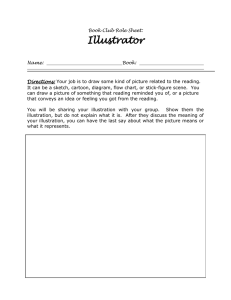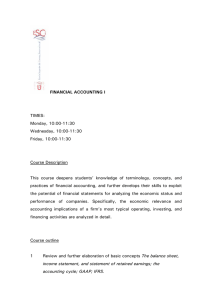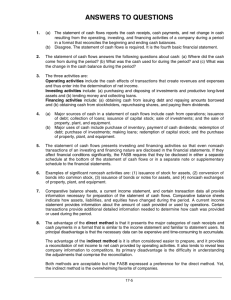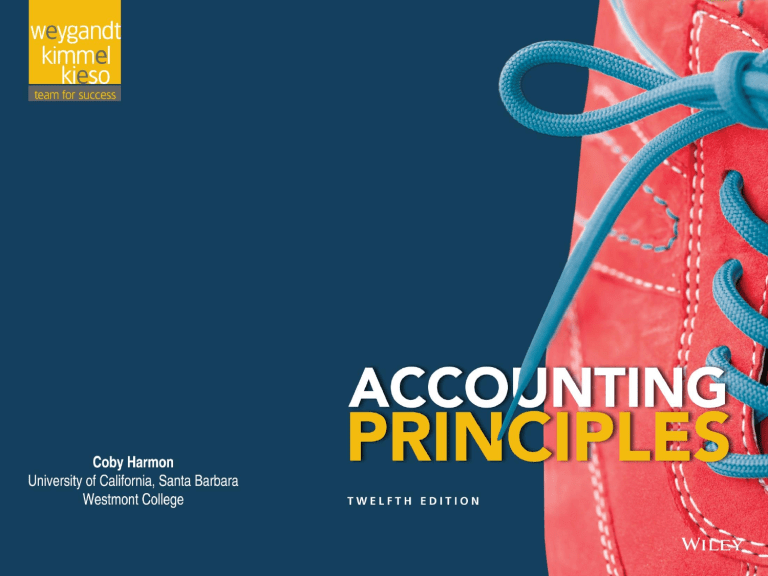
17-1 17 Statement of Cash Flows Learning Objectives 17-2 1 Discuss the usefulness and format of the statement of cash flows. 2 Prepare a statement of cash flows using the indirect method. 3 Analyze the statement of cash flows. LEARNING OBJECTIVE 1 Discuss the usefulness and format of the statement of cash flows. Usefulness of the Statement of Cash Flows Provides information to help assess: 1. Entity’s ability to generate future cash flows. 2. Entity’s ability to pay dividends and meet obligations. 3. Reasons for difference between net income and net cash provided (used) by operating activities. 4. Cash investing and financing transactions during the period. 17-3 LO 1 Classification of Cash Flows Operating Activities Investing Activities Financing Activities Income Changes in Investments and Long-Term Asset Items Changes in Long-Term Liabilities and Stockholders’ Equity Items Statement Items 17-4 LO 1 Classification of Cash Flows Operating activities—Income statement items Cash inflows: From sale of goods or services. Illustration 17-1 Typical receipt and payment classifications From interest received and dividends received. Cash outflows: To suppliers for inventory. To employees for wages. To government for taxes. To lenders for interest. To others for expenses. 17-5 LO 1 Classification of Cash Flows Investing activities—Changes in investments and long-term assets Illustration 17-1 Cash inflows: Typical receipt and payment classifications From sale of property, plant, and equipment. From sale of investments in debt or equity securities of other entities. From collection of principal on loans to other entities. Cash outflows: To purchase property, plant, and equipment. To purchase investments in debt or equity securities of other entities. To make loans to other entities. 17-6 LO 1 Classification of Cash Flows Financing activities—Changes in long-term liabilities and stockholders’ equity Illustration 17-1 Cash inflows: Typical receipt and payment classifications From sale of common stock. From issuance of debt (bonds and notes). Cash outflows: To stockholders as dividends. To redeem long-term debt or reacquire capital stock (treasury stock). 17-7 LO 1 Significant Noncash Activities 1. Direct issuance of common stock to purchase assets. 2. Conversion of bonds into common stock. 3. Issuance of debt to purchase assets. 4. Exchanges of plant assets. Companies report noncash activities in either a 17-8 separate schedule (bottom of the statement) or separate note to the financial statements. LO 1 Accounting Across the Organization Net What? 17-9 LO 1 Format of the Statement of Cash Flows Order of Presentation: 1. Operating activities. 2. Investing activities. Direct Method Indirect Method 3. Financing activities. 17-10 LO 1 Illustration 17-2 Format of statement of cash flows 17-11 LO 1 DO IT! 1 Classification of Cash Flows Illustration: Classify each of these transactions by type of cash flow activity. 1. Issued 100,000 shares of $5 par value common stock for $800,000 cash. Financing 2. Borrowed $200,000 from Castle Bank, signing a 5-year note bearing 8% interest. Financing 3. Purchased two semi-trailer trucks for $170,000 cash. Investing 4. Paid employees $12,000 for salaries and wages. Operating 5. Collected $20,000 cash for services performed. Operating 17-12 LO 1 LEARNING OBJECTIVE 2 Prepare a statement of cash flows using the indirect method. Three sources of information: 1. Comparative balance sheets 2. Current income statement 3. Additional information 17-13 LO 2 Preparing the Statement of Cash Flows Three Major Steps: Illustration 17-3 17-14 LO 2 Preparing the Statement of Cash Flows Three Major Steps: Illustration 17-3 17-15 LO 2 Preparing the Statement of Cash Flows Three Major Steps: Illustration 17-3 17-16 LO 2 Indirect and Direct Methods Companies favor the indirect method for two reasons: 1. Easier and less costly to prepare. 2. Focuses on differences between net income and net cash flow from operating activities. 17-17 LO 2 Indirect Method COMPUTER SERVICES COMPANY Income Statement For the Month Ended December 31, 2017 Illustration 17-4 17-18 LO 2 Indirect Method Illustration 17-4 2017 17-19 2016 LO 2 Indirect Method Illustration 17-4 Additional information for 2017: 1. Depreciation expense was comprised of $6,000 for building and $3,000 for equipment. 2. The company sold equipment with a book value of $7,000 (cost $8,000, less accumulated depreciation $1,000) for $4,000 cash. 3. Issued $110,000 of long-term bonds in direct exchange for land. 4. A building costing $120,000 was purchased for cash. Equipment costing $25,000 was also purchased for cash. 5. Issued common stock for $20,000 cash. 6. The company declared and paid a $29,000 cash dividend. 17-20 LO 2 Step 1: Operating Activities DETERMINE NET CASH PROVIDED/USED BY OPERATING ACTIVITIES BY CONVERTING NET INCOME FROM ACCRUAL BASIS TO CASH BASIS. Common adjustments to Net Income (Loss): Add back non-cash expenses (depreciation, amortization, or depletion expense). Deduct gains and add losses. Analyze changes in noncash current asset and current liability accounts. 17-21 LO 2 Step 1: Operating Activities Question Which is an example of a cash flow from an operating activity? a. Payment of cash to lenders for interest. b. Receipt of cash from the sale of capital stock. c. Payment of cash dividends to the company’s stockholders. d. None of the above. 17-22 LO 2 Step 1: Operating Activities DEPRECIATION EXPENSE Although depreciation expense reduces net income, it does not reduce cash. The company must add it back to net income. Illustration 17-6 Cash flows from operating activities: Net income $ 145,000 Adjustments to reconcile net income to net cash provided by operating activities: Depreciation expense Net cash provided by operating activities 17-23 9,000 $ 154,000 LO 2 Step 1: Operating Activities LOSS ON DISPOSAL OF EQUIPMENT Companies report as a source of cash in the investing activities section the actual amount of cash received from the sale. Any loss on disposal is added to net income in the operating section. Any gain on disposal is deducted from net income in the operating section. 17-24 LO 2 Step 1: Operating Activities LOSS ON DISPOSAL OF EQUIPMENT Illustration 17-7 Cash flows from operating activities: Net income $ 145,000 Adjustments to reconcile net income to net cash provided by operating activities: Depreciation expense 9,000 Loss on disposal of equipment 3,000 Net cash provided by operating activities 17-25 $ 157,000 LO 2 Step 1: Operating Activities CHANGES TO NONCASH CURRENT ASSET When the Accounts Receivable balance decreases, cash receipts are higher than revenue earned under the accrual basis. Accounts Receivable 1/1/017 Balance Sales Revenue 12/31/17 Balance 30,000 507,000 Receipts from customers Illustration 17-8 517,000 20,000 Company adds to net income the amount of the decrease in accounts receivable. 17-26 LO 2 Step 1: Operating Activities CHANGES TO NONCASH CURRENT ASSET Illustration 17-9 Cash flows from operating activities: Net income $ 145,000 Adjustments to reconcile net income to net cash provided by operating activities: Depreciation expense 9,000 Loss on disposal of equipment 3,000 Decrease in accounts receivable Net cash provided by operating activities 17-27 10,000 $ 167,000 LO 2 Step 1: Operating Activities CHANGES TO NONCASH CURRENT ASSET When the Inventory balance increases, the cost of merchandise purchased exceeds the cost of goods sold. Inventory 1/1/17 Balance Purchases 12/31/17 Balance 10,000 155,000 Cost of goods sold 150,000 15,000 Cost of goods sold does not reflect cash payments made for merchandise. The company deducts from net income this inventory increase. 17-28 LO 2 Step 1: Operating Activities CHANGES TO NONCASH CURRENT ASSET Illustration 17-9 Cash flows from operating activities: Net income $ 145,000 Adjustments to reconcile net income to net cash provided by operating activities: Depreciation expense 9,000 Loss on disposal of equipment 3,000 Decrease in accounts receivable 10,000 Increase in inventory (5,000) Net cash provided by operating activities 17-29 $ 162,000 LO 2 Step 1: Operating Activities CHANGES TO NONCASH CURRENT ASSET When the Prepaid Expense balance increases, cash paid for expenses is higher than expenses reported on an accrual basis. The company deducts the decrease from net income to arrive at net cash provided by operating activities. If prepaid expenses decrease, reported expenses are higher than the expenses paid. 17-30 LO 2 Step 1: Operating Activities CHANGES TO NONCASH CURRENT ASSET Illustration 17-9 Cash flows from operating activities: Net income $ 145,000 Adjustments to reconcile net income to net cash provided by operating activities: Depreciation expense 9,000 Loss on disposal of equipment 3,000 Decrease in accounts receivable 10,000 Increase in inventory (5,000) Increase in prepaid expenses (4,000) Net cash provided by operating activities 17-31 $ 158,000 LO 2 Step 1: Operating Activities CHANGES IN CURRENT LIABILITIES When Accounts Payable increases, the company received more in goods than it actually paid for. The increase is added to net income to determine net cash provided by operating activities. When Income Tax Payable decreases, the income tax expense reported on the income statement was less than the amount of taxes paid during the period. The decrease is subtracted from net income to determine net cash provided by operating activities. 17-32 LO 2 Step 1: Operating Activities CHANGES IN CURRENT LIABILITIES Illustration 17-10 Cash flows from operating activities: Net income $ 145,000 Adjustments to reconcile net income to net cash provided by operating activities: Depreciation expense 9,000 Loss on disposal of equipment 3,000 Decrease in accounts receivable 10,000 Increase in inventory (5,000) Increase in prepaid expenses (4,000) Increase in accounts payable 16,000 Decrease in income taxes payable (2,000) Net cash provided by operating activities 17-33 $ 172,000 LO 2 Step 1: Operating Activities Summary of Conversion to Net Cash Provided by Operating Activities—Indirect Method Illustration 17-11 17-34 LO 2 DO IT! 2a Cash from Operating Activities Josh’s PhotoPlus reported net income of $73,000 for 2017. Included in the income statement were depreciation expense of $7,000 and a gain on disposal of equipment of $2,500. Josh’s comparative balance sheets show the following balances. Accounts receivable Accounts payable 12/31/16 12/31/17 $17,000 $21,000 6,000 2,200 Calculate net cash provided by operating activities for Josh’s PhotoPlus. 17-35 LO 2 DO IT! 2a Cash from Operating Activities Josh’s PhotoPlus reported net income of $73,000 for 2017, which included depreciation expense of $7,000 and a gain on disposal of equipment of $2,500. Accounts receivable increased $4,000 and accounts payable decreased by $3,800. Calculate net cash provided by operating activities. 17-36 LO 2 Step 2: Investing and Financing Activities Company purchased land of $110,000 by issuing long-term bonds. This is a significant noncash investing and financing activity that merits disclosure in a separate schedule. Land 1/1/17 Balance Issued bonds 12/31/17 Balance 20,000 110,000 130,000 Bonds Payable 1/1/17 17-37 Balance For land 20,000 110,000 12/31/17 Balance 130,000 LO 2 Step 2: Investing and Financing Activities Partial statement 17-38 Illustration 17-13 Net cash provided by operating activities Cash flows from investing activities: Purchase of building Purchase of equipment Sale of equipment Net cash used by investing activities Cash flows from financing activities: Issuance of common stock Payment of cash dividends Net cash used by financing activities Net increase in cash Cash at beginning of period Cash at end of period 172,000 $ 20,000 (29,000) (9,000) 22,000 33,000 55,000 Disclosure: Issuance of bonds to purchase land $ 110,000 (120,000) (25,000) 4,000 (141,000) LO 2 Step 2: Investing and Financing Activities From the additional information, the company acquired an office building for $120,000 cash. This is a cash outflow reported in the investing section. Building 1/1/17 Balance Office building 12/31/17 Balance 17-39 40,000 120,000 160,000 LO 2 Step 2: Investing and Financing Activities Partial statement 17-40 Illustration 17-13 Net cash provided by operating activities Cash flows from investing activities: Purchase of building Purchase of equipment Sale of equipment Net cash used by investing activities Cash flows from financing activities: Issuance of common stock Payment of cash dividends Net cash used by financing activities Net increase in cash Cash at beginning of period Cash at end of period 172,000 $ 20,000 (29,000) (9,000) 22,000 33,000 55,000 Disclosure: Issuance of bonds to purchase land $ 110,000 (120,000) (25,000) 4,000 (141,000) LO 2 Step 2: Investing and Financing Activities The additional information explains that the equipment increase resulted from two transactions: (1) a purchase of equipment of $25,000, and (2) the sale for $4,000 of equipment costing $8,000. Illustration 17-12 Equipment 1/1/17 Balance Purchase 12/31/17 Balance Journal Entry 17-41 10,000 25,000 Equipment sold 8,000 27,000 Cash Accumulated Depreciation Loss on Disposal of Equipment Equipment 4,000 1,000 3,000 8,000 LO 2 Statement of Cash Flows Indirect Method 17-42 Illustration 17-13 Cash flows from operating activities: Net income Adjustments to reconcile net income to net cash provided by operating activities: Depreciation expense Loss on disposal of equipment Decrease in accounts receivable Increase in inventory Increase in prepaid expenses Increase in accounts payable Decrease in income taxes payable Net cash provided by operating activities Cash flows from investing activities: Purchase of building Purchase of equipment Sale of equipment Net cash used by investing activities Cash flows from financing activities: Issuance of common stock Payment of cash dividends Net cash used by financing activities Net increase in cash Cash at beginning of period Cash at end of period $ 145,000 9,000 3,000 10,000 (5,000) (4,000) 16,000 (2,000) 172,000 (120,000) (25,000) 4,000 (141,000) $ 20,000 (29,000) (9,000) 22,000 33,000 55,000 LO 2 Step 2: Investing and Financing Activities The increase in common stock resulted from the issuance of new shares. Common Stock 1/1/17 Balance Shares sold 12/31/17 Balance 17-43 50,000 20,000 70,000 LO 2 Step 2: Investing and Financing Activities Illustration 17-13 Partial statement 17-44 Net cash provided by operating activities Cash flows from investing activities: Purchase of building Purchase of equipment Sale of equipment Net cash used by investing activities Cash flows from financing activities: Issuance of common stock Payment of cash dividends Net cash used by financing activities Net increase in cash Cash at beginning of period Cash at end of period 172,000 $ 20,000 (29,000) (9,000) 22,000 33,000 55,000 Disclosure: Issuance of bonds to purchase land $ 110,000 (120,000) (25,000) 4,000 (141,000) LO 2 Step 2: Investing and Financing Activities Retained earnings increased $116,000 during the year. This increase can be explained by two factors: (1) Net income of $145,000 increased retained earnings, and (2) Dividends of $29,000 decreased retained earnings. Retained Earnings Dividends 29,000 1/1/17 Balance Net income 12/31/17 Balance 17-45 48,000 145,000 164,000 LO 2 Statement of Cash Flows Indirect Method 17-46 Illustration 17-13 Cash flows from operating activities: Net income Adjustments to reconcile net income to net cash provided by operating activities: Depreciation expense Loss on disposal of equipment Decrease in accounts receivable Increase in inventory Increase in prepaid expenses Increase in accounts payable Decrease in income taxes payable Net cash provided by operating activities Cash flows from investing activities: Purchase of building Purchase of equipment Sale of equipment Net cash used by investing activities Cash flows from financing activities: Issuance of common stock Payment of cash dividends Net cash used by financing activities Net increase in cash Cash at beginning of period Cash at end of period $ 145,000 9,000 3,000 10,000 (5,000) (4,000) 16,000 (2,000) 172,000 (120,000) (25,000) 4,000 (141,000) $ 20,000 (29,000) (9,000) 22,000 33,000 55,000 LO 2 Step 2: Investing and Financing Activities Question Which is an example of a cash flow from an investing activity? a. Receipt of cash from the issuance of bonds payable. b. Payment of cash to repurchase outstanding capital stock. c. Receipt of cash from the sale of equipment. d. Payment of cash to suppliers for inventory. 17-47 LO 2 Step 3: Net Change in Cash Compare the net change in cash on the Statement of Cash Flows with the change in the cash account reported on the Balance Sheet to make sure the amounts agree. Illustration 17-4 2017 17-48 2016 LO 2 Accounting Across the Organization Burning Through Our Cash Box (cloud storage), Cyan (game creator), Fireeye (cyber security), and Mobile Iron (mobile security of data) are a few of the tech companies that recently have issued or are about to issue stock to the public. Investors now have to determine whether these tech companies have viable products and high chances for success. An important consideration in evaluating a tech company is determining its financial flexibility—its ability to withstand adversity if an economic setback occurs. One way to measure financial flexibility is to assess a company’s cash burn rate, which determines how long its cash will hold out if the company is expending more cash than it is receiving. Fireeye, for example, burned cash in excess of $50 million in 2013. But the company also had over $150 million as a cash cushion, so it would take over 30 months before it runs out of cash. And even though Box has a much lower cash burn rate than Fireeye, it still has over a year’s cushion. Compare that to the tech companies in 2000, when over one-quarter of them were on track to run out of cash within a year. And many did. Fortunately, the tech companies of today seem to be better equipped to withstand an economic setback. Source: Shira Ovide, “Tech Firms’ Cash Hoards Cool Fears of a Meltdown,” Wall Street Journal (May 14, 2014). 17-49 LO 2 LEARNING OBJECTIVE 3 Analyze the statement of cash flows. Free Cash Flow Illustration 17-14 Free cash flow describes the cash remaining from operations after adjustment for capital expenditures and dividends. 17-50 LO 3 Free Cash Flow Illustration 17-15 Microsoft’s cash flow information ($ in millions) Required: Calculate Microsoft’s free cash flow. Cash provided by operating activities Less: Expenditures on property, plant, and equipment Dividends paid Free cash flow 17-51 $21,863 4,257 7,455 $10,151 LO 3 LEARNING OBJECTIVE 4 APPENDIX 17A: Statement of Cash Flows Using the Direct Method. 1. Compute net cash provided by operating activities by adjusting each item in the income statement from the accrual basis to the cash basis. 2. Companies report only major classes of operating cash receipts and cash payments. 3. For these major classes, the difference between cash receipts and cash payments is the net cash provided by operating activities. 17-52 LO 4 Step 1: Operating Activities 17-53 Illustration 17A-2 Major classes of cash receipts and payments LO 4 Direct Method COMPUTER SERVICES COMPANY Income Statement For the Month Ended December 31, 2017 Illustration 17-4 17-54 LO 4 Direct Method Illustration 17-4 2017 17-55 2016 LO 4 Direct Method Illustration 17-4 Additional information for 2017: 1. Depreciation expense was comprised of $6,000 for building and $3,000 for equipment. 2. The company sold equipment with a book value of $7,000 (cost $8,000, less accumulated depreciation $1,000) for $4,000 cash. 3. Issued $110,000 of long-term bonds in direct exchange for land. 4. A building costing $120,000 was purchased for cash. Equipment costing $25,000 was also purchased for cash. 5. Issued common stock for $20,000 cash. 6. The company declared and paid a $29,000 cash dividend. 17-56 LO 4 Step 1: Operating Activities Cash Receipts from Customers For Computer Services, accounts receivable decreased $10,000. Illustration 17A-4 Accounts Receivable 1/1/017 Balance Sales revenue 12/31/17 Balance 30,000 507,000 Receipts from customers 517,000 20,000 Illustration 17A-5 17-57 LO 4 Step 1: Operating Activities Cash Payments to Suppliers In 2017, Computer Services Company’s inventory increased $5,000 and cash payments to suppliers were $139,000. Inventory 1/1/17 Balance Purchases 12/31/17 Balance 10,000 155,000 Cost of goods sold 15,000 Illustration 17A-8 Accounts Payable Payment to suppliers 139,000 1/1/17 Balance Purchases 12/31/17 17-58 150,000 Balance 12,000 155,000 28,000 LO 4 Step 1: Operating Activities Cash Payments to Suppliers In 2017, Computer Services Company’s inventory increased $5,000 and cash payments to suppliers were $139,000. Illustration 17A-10 Formula to compute cash payments to suppliers—direct method 17-59 LO 4 Step 1: Operating Activities Cash Payments for Operating Expenses Cash payments for operating expenses were $115,000. Illustration 17A-11 Illustration 17A-12 17-60 LO 4 Step 1: Operating Activities Cash Payments for Interest In 2017, Computer Services’ had interest expense of $42,000. Interest Payable Cash paid for interest 42,000 1/1/17 Balance Interest expense 12/31/17 Balance 17-61 0 42,000 0 LO 4 Step 1: Operating Activities Cash Payments for Income Taxes Cash payments for income taxes were $49,000. Income Tax Payable Cash paid for taxes 49,000 1/1/17 Balance Income tax expense 12/31/17 Balance 8,000 47,000 6,000 Illustration 17A-15 17-62 LO 4 Step 1: Operating Activities Illustration 17A-16 Operating activities section of the statement of cash flows 17-63 LO 4 Step 2: Investing and Financing Activities Increase in Equipment. (1) Equipment purchased for $25,000, and (2) equipment sold for $4,000, cost $8,000, book value $7,000. Equipment 1/1/17 Balance Purchases 12/31/17 Balance 10,000 25,000 Illustration 17A-17 Cost of equipment sold 8,000 27,000 Accumulated Depreciation Equipment sold 1,000 1/1/17 Balance 1,000 Depreciation expense 3,000 12/31/17 Balance 17-64 3,000 LO 4 Step 2: Investing and Financing Activities Increase in Equipment. (1) Equipment purchased for $25,000, and (2) equipment sold for $4,000, cost $8,000, book value $7,000. Cash 4,000 Accumulated Depreciation 1,000 Loss on Disposal of Equipment 3,000 Equipment 17-65 8,000 LO 4 Step 2: Investing and Financing Activities Increase in Land. Land increased $110,000. The company purchased land of $110,000 by issuing bonds. Significant noncash investing and financing transaction. Increase in Building. Acquired building for $120,000 cash. Investing transaction. Increase in Bonds Payable. Bonds Payable increased $110,000. The company acquired land by exchanging bonds for land. Significant noncash investing and financing transaction. 17-66 LO 4 Step 2: Investing and Financing Activities Increase in Common Stock. Increase in Common Stock of $20,000. Increase resulted from the issuance of new shares of stock. Increase in Retained Earnings. The $116,000 net increase in Retained Earnings resulted from net income of $145,000 and the declaration and payment of a cash dividend of $29,000. 17-67 Financing transaction. Financing transaction (cash dividend) LO 4 Illustration 17A-18 Statement of cash flows, 2017—direct method 17-68 LO 4 Step 3: Net Change in Cash Compare the net change in cash on the Statement of Cash Flows with the change in the cash account reported on the Balance Sheet to make sure the amounts agree. Illustration 17-4 2017 17-69 2016 LO 4 LEARNING OBJECTIVE Illustration 17B-2 Comparative balance sheets, income statement, and additional information for Computer Services Company 17-70 5 APPENDIX 17B: Use a worksheet to prepare the statement of cash flows using the indirect method. Preparing the Worksheet Illustration 17B-2 Comparative balance sheets, income statement, and additional information for Computer Services Company Additional information for 2017: 1. Depreciation expense was comprised of $6,000 for building and $3,000 for equipment. 2. The company sold equipment with a book value of $7,000 (cost $8,000, less accumulated depreciation $1,000) for $4,000 cash. 3. Issued $110,000 of long-term bonds in direct exchange for land. 4. A building costing $120,000 was purchased for cash. Equipment costing $25,000 was also purchased for cash. 5. Issued common stock for $20,000 cash. 6. The company declared and paid a $29,000 cash dividend. 17-71 LO 5 Preparing the Worksheet 1. Enter in the balance sheet accounts section the balance sheet accounts and their beginning and ending balances. 2. Enter in the reconciling columns of the worksheet the data that explain the changes in the balance sheet accounts other than cash and their effects on the statement of cash flows. 3. Enter on the cash line and at the bottom of the worksheet the increase or decrease in cash. This entry should enable the totals of the reconciling columns to be in agreement. 17-72 LO 5 Preparing the Worksheet Illustration 17B-3 Completed worksheet— indirect method 17-73 LO 5 LEARNING OBJECTIVE 6 APPENDIX 17C: Use the T-account approach to prepare a statement of cash flows. The change in cash is equal to the change in all of the other balance sheet accounts. If we analyze the changes in all of the noncash balance sheet accounts, we will explain the change in the cash account. 17-74 LO 6 Illustration 17C-1 17-75 LO 6 A Look at IFRS LEARNING OBJECTIVE 7 Compare the procedures for the statement of cash flows under GAAP and IFRS. Relevant Facts Similarities Companies preparing financial statements under IFRS must prepare a statement of cash flows as an integral part of the financial statements. Both IFRS and GAAP require that the statement of cash flows should have three major sections—operating, investing, and financing—along with changes in cash and cash equivalents. 17-76 LO 7 A Look at IFRS Relevant Facts Similar to GAAP, the cash flow statement can be prepared using either the indirect or direct method under IFRS. In both U.S. and international settings, companies choose for the most part to use the indirect method for reporting net cash flows from operating activities. The definition of cash equivalents used in IFRS is similar to that used in GAAP. A major difference is that in certain situations, bank overdrafts are considered part of cash and cash equivalents under IFRS (which is not the case in GAAP). Under GAAP, bank overdrafts are classified as financing activities in the statement of cash flows and are reported as liabilities on the balance sheet. 17-77 LO 7 A Look at IFRS Relevant Facts Differences IFRS requires that noncash investing and financing activities be excluded from the statement of cash flows. Instead, these noncash activities should be reported elsewhere. This requirement is interpreted to mean that noncash investing and financing activities should be disclosed in the notes to the financial statements instead of in the financial statements. Under GAAP, companies may present this information on the face of the statement of cash flows. 17-78 LO 7 A Look at IFRS Relevant Facts One area where there can be substantial differences between IFRS and GAAP relates to the classification of interest, dividends, and taxes. The following table indicates the differences between the two approaches. 17-79 LO 7 A Look at IFRS Relevant Facts Under IFRS, some companies present the operating section in a single line item, with a full reconciliation provided in the notes to the financial statements. This presentation is not seen under GAAP. 17-80 LO 7 A Look at IFRS Looking to the Future Presently, the FASB and the IASB are involved in a joint project on the presentation and organization of information in the financial statements. One interesting approach, revealed in a published proposal from that project, is that in the future the income statement and balance sheet would adopt headings similar to those of the statement of cash flows. That is, the income statement and balance sheet would be broken into operating, investing, and financing sections. 17-81 LO 7 A Look at IFRS IFRS Self-Test Questions Under IFRS, interest paid can be reported as: a) only a financing element. b) a financing element or an investing element. c) a financing element or an operating element. d) only an operating element. 17-82 LO 7 A Look at IFRS IFRS Self-Test Questions IFRS requires that noncash items: a) be reported in the section to which they relate, that is, a noncash investing activity would be reported in the investing section. b) be disclosed in the notes to the financial statements. c) do not need to be reported. d) be treated in a fashion similar to cash equivalents. 17-83 LO 7 A Look at IFRS IFRS Self-Test Questions In the future, it appears likely that: a) the income statement and balance sheet will have headings of operating, investing, and financing, much like the statement of cash flows. b) cash and cash equivalents will be combined in a single line item. c) the IASB will not allow companies to use the direct approach to the statement of cash flows. d) None of the above. 17-84 LO 7 Copyright “Copyright © 2015 John Wiley & Sons, Inc. All rights reserved. Reproduction or translation of this work beyond that permitted in Section 117 of the 1976 United States Copyright Act without the express written permission of the copyright owner is unlawful. Request for further information should be addressed to the Permissions Department, John Wiley & Sons, Inc. The purchaser may make back-up copies for his/her own use only and not for distribution or resale. The Publisher assumes no responsibility for errors, omissions, or damages, caused by the use of these programs or from the use of the information contained herein.” 17-85


